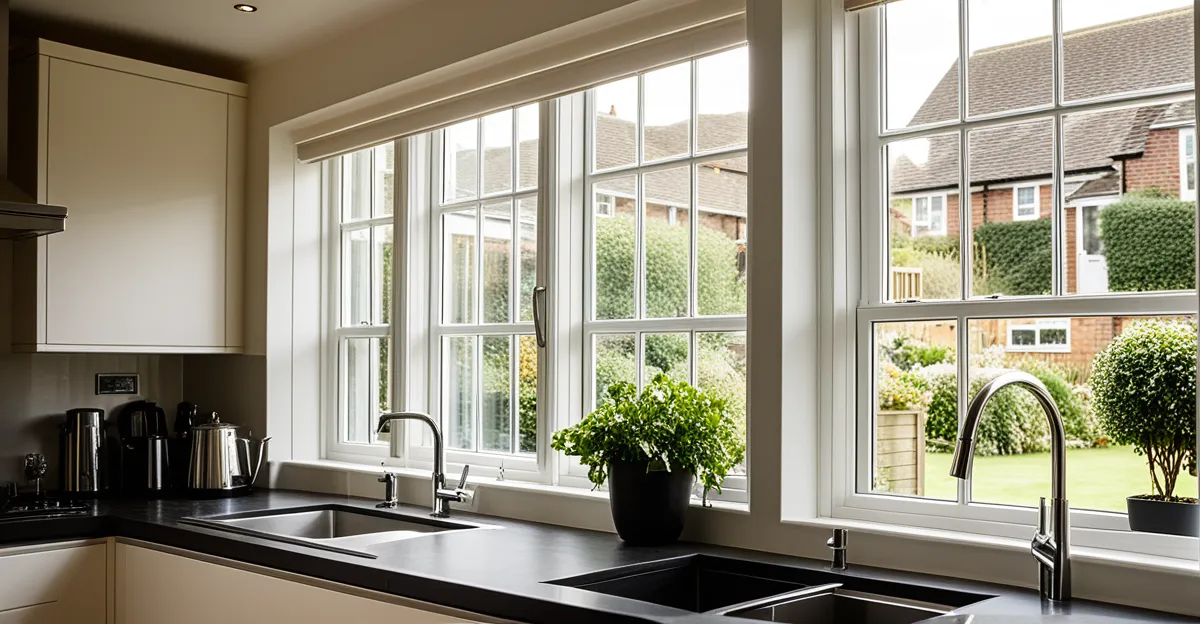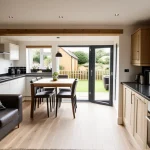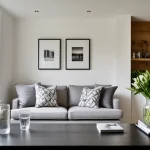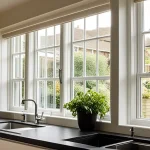Practical room layout strategies for maximising natural light
Maximising natural light in UK living room design begins with thoughtful furniture placement. Positioning larger items away from windows is essential to prevent blocking the flow of daylight. For example, avoid placing tall bookcases or bulky sofas directly in front of windows, as this can drastically reduce the amount of sunlight entering the room. Instead, orienting furniture towards window areas encourages daylight to permeate deeper into the space.
Creating an open floor plan also plays a crucial role in enhancing light distribution. By minimising unnecessary partitions and opting for clear sightlines, natural light can travel freely throughout the living room. This approach not only brightens the area but also gives a greater sense of spaciousness, which is especially beneficial in typically compact UK homes.
Also to read : How Can Small Changes Revitalize Your UK Home Interior?
Choosing lighter or multifunctional furniture further supports an airy ambiance. Light-coloured materials reflect more light, maintaining the brightness achieved through smart window placement and open layouts. Additionally, multifunctional pieces with slim profiles reduce visual clutter while preserving open pathways for sunlight. Combining these strategies in a unified plan is key for an effective UK living room design that truly maximises natural light.
Choosing window treatments to enhance daylight
Selecting the right window treatments is vital for enhancing daylight in UK living room design. Sheer or light-filtering curtains are excellent choices because they allow sunlight to diffuse softly throughout the space. Unlike heavy drapes, these materials let in plenty of natural light while reducing glare, striking a balance between brightness and comfort. For instance, voile or linen fabrics can brighten a room significantly without compromising privacy.
Have you seen this : How can UK residents transform small homes for maximum comfort?
When considering blinds for maximising natural light, opt for minimalist, unobtrusive styles such as slimline roller blinds or Venetian blinds in light tones. These designs do not obstruct daylight flow when open and can be adjusted to control the amount of light and privacy needed throughout the day. Unlike bulky window coverings, they maintain the open feeling that is crucial for UK living room design.
Layered treatments provide a clever solution to balance privacy with daylight. Combining sheer curtains with roller blinds or shutters offers flexibility: you can draw blinds for privacy during the evening while still enjoying soft daylight filtering through sheer panels earlier in the day. This approach works particularly well in urban settings where privacy and sunlight both matter, ensuring that furniture placement near window areas benefits fully from natural light.
Optimising colour palettes for brighter spaces
Selecting the right colour palettes is a powerful way to enhance brightness and complement efforts in maximising natural light within a UK living room design. Light-reflective paint finishes, such as eggshell or satin, help bounce daylight deeper into the room, amplifying its effect. Neutral tones like soft whites, creams, and pale greys form an ideal base, creating an inviting and airy atmosphere.
In addition to walls, opting for paint colours in pale or warm shades on ceilings and trim can further contribute to brightening rooms. These subtle hues reflect light without overwhelming the space, maintaining a harmonious flow. Integrating soft furnishings in matching or complementary colours—such as cushions, throws, or rugs—reinforces this effect, enhancing a cohesive, light-enhanced look.
To prevent monotony and add personality, consider accentuating the room with well-placed colour pops. Accessories in muted blues, gentle greens, or warm yellows can lift the mood without detracting from the overall brightness. Thoughtful use of colour palettes not only complements furniture placement strategies but also plays a crucial role in optimising natural light and elevating the visual impact of any UK living room design.
Strategic mirror and reflective surface placement
Using mirrors strategically in a UK living room design is a highly effective method for maximising natural light. Positioning mirrors directly opposite or adjacent to windows allows them to capture and reflect daylight deeper into the room. This simple technique doubles the perceived light, brightening areas that might otherwise remain shadowed, especially in rooms with limited window space.
Incorporating reflective surfaces such as glass, chrome, or glossy finishes further enhances light distribution. Items like glass coffee tables, metallic lamp bases, or glossy picture frames act as secondary light sources by bouncing daylight around the room. This effect not only brightens the space but also adds a modern, sophisticated touch to the decor without sacrificing functionality.
Creating focal points using mirrored or metallic decor combines aesthetics with practicality. For instance, a large decorative mirror above a fireplace or a collection of smaller, artfully arranged mirrors can become eye-catching features while enhancing brightness. Similarly, metallic accessories can add subtle shimmer that complements furniture placement and colour palettes, contributing to an overall lighter, more open ambiance in UK living rooms.
By thoughtfully integrating mirrors and reflective surfaces, homeowners can effectively overcome common lighting challenges, making their living spaces feel more expansive and naturally illuminated throughout the day.
Addressing UK-specific light challenges
Maximising natural light in UK living room design requires tailored strategies due to frequent cloudy days and often small or north-facing windows. Rooms with limited window size naturally receive less direct sunlight, posing a significant challenge to brightness. The key is to creatively enhance available daylight rather than rely solely on window size.
One practical approach involves introducing skylights, which bring in additional natural light from above, bypassing obstacles that block side windows. Skylights can dramatically increase brightness, especially in rooms with low or shaded window exposure common in UK homes. When skylight installation is impractical, internal glass partitions offer an alternative by allowing light to flow between rooms, creating a brighter, more open feel throughout the home.
Overcast weather typical in the UK demands maximising reflection and diffusion of daylight. Layered window treatments with sheer fabrics enable soft light penetration even on dull days without sacrificing privacy. Additionally, arranging furniture to keep window areas clear and using light colours on walls enhance the effect of diffuse light. Employing these solutions collectively addresses the UK daylight challenges, ensuring living spaces remain inviting despite exterior conditions.
Visual inspiration and expert recommendations
Visual examples play a crucial role in illustrating effective ways to maximise natural light within a UK living room design. Before-and-after photo comparisons provide a clear, tangible demonstration of how strategic furniture placement, colour palettes, and window treatments can transform a space from dim and enclosed to bright and inviting. These comparisons help homeowners visualise potential improvements and better understand the impact of key design choices on daylight optimisation.
Showcasing UK living space transformations offers relevant, relatable inspiration. Many UK homes face similar lighting challenges such as small windows or limited daylight hours, so seeing successful redesigns in comparable settings reassures homeowners that achieving a naturally bright environment is possible. These examples often highlight practical solutions combining open floor plans, light-reflective decor, and carefully selected furniture placement to enhance natural light effectively.
Expert advice complements visual inspiration by providing targeted recommendations for homeowners. Interior designers frequently emphasise the importance of layering window treatments to balance daylight and privacy, choosing multifunctional furniture to maintain openness, and incorporating reflective surfaces to distribute light throughout the room. They also recommend using light colours on walls and ceilings to amplify daylight and suggest specific products such as slimline blinds or sheer curtains tailored for UK lighting conditions.
Together, visual examples and expert insights offer comprehensive guidance. By studying well-executed layouts and applying professional tips, homeowners can confidently implement strategies for maximising natural light in their UK living rooms, creating brighter, more welcoming spaces.







